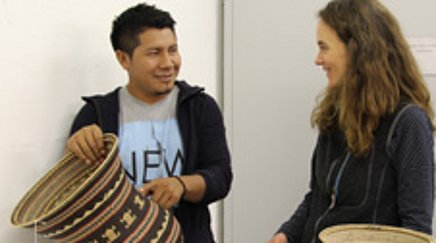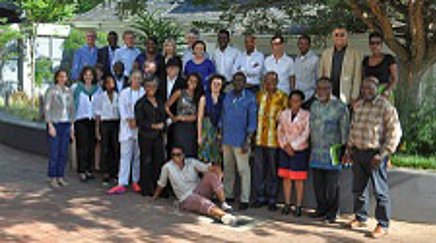The Move: From Dahlem to Mitte
04.11.2016The Move: From Dahlem to Mitte
The move of Dahlem’s non-European collections to the Humboldt Forum has been going on since the beginning of 2016. Each object has to be inspected, restored, and appropriately packed before it can be transported to the reconstructed City Palace. Here we look at some of the most exciting objects and learn the stories behind them.
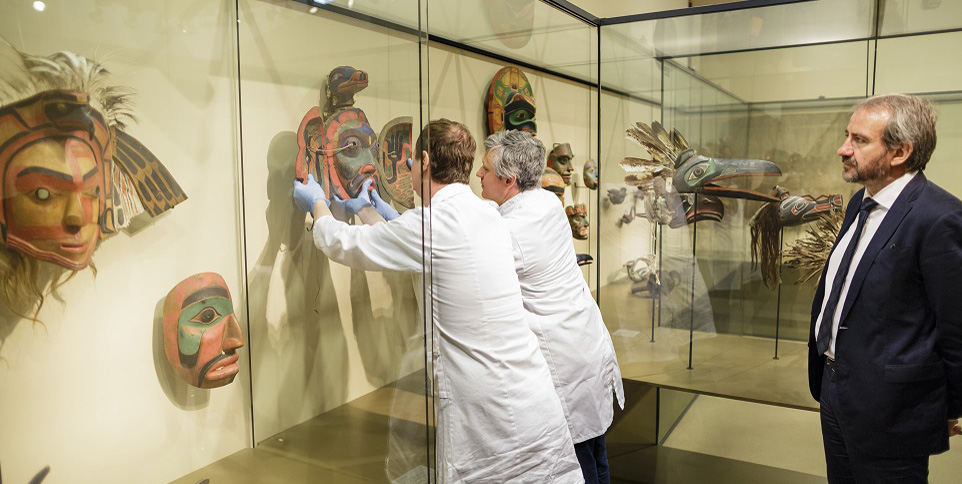
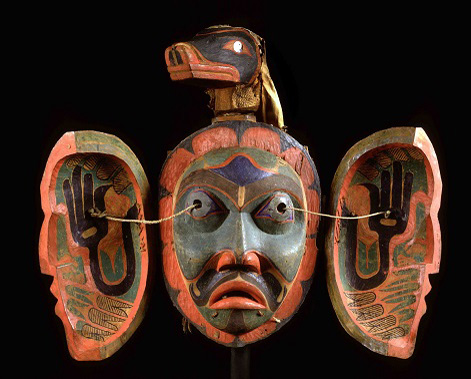
Nulis Mask – An Icon for the Humboldt Forum
It is the Nefertiti, so to speak, of the Humboldt Forum. The transformation mask of the Kwakwaka'wakw – known as the Nulis mask – is an iconic object in the collection of the Ethnologisches Museum (Ethnological Museum). So to mark the symbolic start of the move from Dahlem to Mitte in mid-April 2016, the Nulis mask was packed in the presence of the SPK's President, Hermann Parzinger. It was acquired in the course of a collecting expedition to the Pacific coast of northwestern America by a Norwegian captain, Adrian Jacobsen, who brought it back to Berlin in 1883. The mask represents Nulis, an ancestor of the Kwakwaka’wakw. When is closed, it shows a dark brown, angry face; when open, it shows a friendly, colorful face. The mask was probably worn at potlatch feasts, which were held as a way of exchanging gifts between the various members of the clan and thus ensuring a fair distribution of goods.
Lienzo Seler II - Large Map of the Mixtec
For almost fifty years, this sixteenth-century Mixtecan cotton cloth, measuring 4 x 4 meters, hung untouched in its glass case at the Ethnologisches Museum in Dahlem. The Lienzo Seler II, as it is called, is apparently a huge map of the Coixtlahuaca Valley, but it also shows the mythological realm, which is separated by a small curtain of leopard skin from the physical topography. The Lienzo symbolically depicts not only the locations of settlements, pre-Hispanic pyramids and temples, watercourses, fields, and footpaths, but also aspects of armed conflict such as the hanging of Indians by a Spanish judge. Before the move, the Lienzo Seler II will be taken out of its case at last, to be studied by historians and analyzed by scientists as a prelude to any necessary restoration work. Once this has been completed, the removals specialists will face the challenge of getting the cloth – which covers 17 square meters when flat – through the doors of the Ethnologisches Museum in Dahlem.
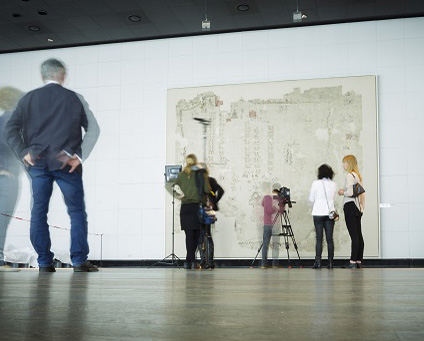
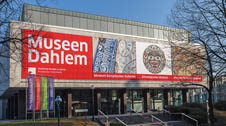
On the Way to the Humboldt Forum
The staff in Dahlem have been making physical preparations for the relocation of the non-European collections to the Humboldt Forum since January 2016. The process is taking place in stages, synchronized with the progress of construction at Schlossplatz. Before being taken to Mitte, every object will be demounted, restored, and prepared for presentation in the Humboldt Forum. The main hall for special exhibitions in Dahlem has been converted into a storage and workshop area for this purpose. Its location within the museum complex makes it ideal for use as a kind of marshalling yard for items on their way to the Humboldt Forum.
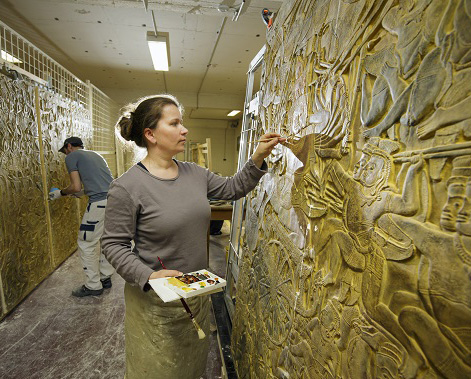
Angkor Wat – Out of Storage and Back in the Spotlight
Casts of the magnificent reliefs of Angkor Wat, Cambodia’s famous temple complex, lay almost forgotten in the storage rooms of the Museum für Asiatische Kunst (Asian Art Museum) for years, but now they are being comprehensively restored. In the new exhibition concept for the Humboldt Forum, the curators and the exhibition designers have put these objects back into the spotlight. Angkor Wat, the greatest work of Khmer architecture, was built mainly during the first half of the twelfth century. The relief carvings illustrate significant legends, depicting the exploits of their main protagonists, Krishna and Rama. The casts of them were acquired at the beginning of the twentieth century, but were later thought to have been destroyed in the Second World War. Then, in the early 1980s, 442 paper-based molds were rediscovered in the Gipsformerei (Replica Workshop). They were used to make new casts, which were built into the walls of what was then the Museum of Indian Art. In 1997, the museum building was altered and they were removed from permanent display. After they have been restored, the casts of the Angkor Wat reliefs will return to a position of prominence, but this time in the Humboldt Forum.
2015: Trial Run for a Boat's Voyage to the Humboldt Forum
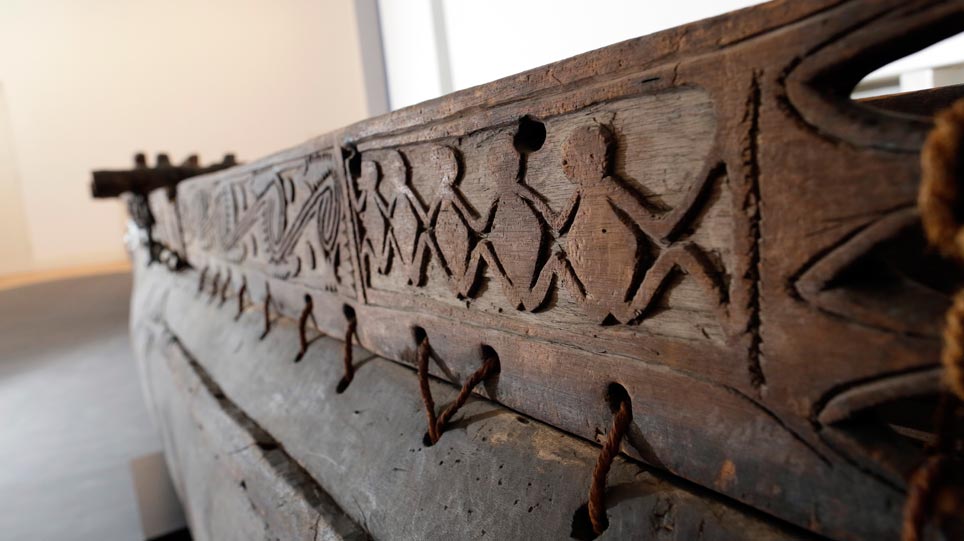
In July 2015, a boat from the South Sea traveled to Dahlem from the Martin-Gropius-Bau. It had been carefully packed by specialists and lifted out through a window by crane, under the watchful eyes of museum staff. The large outrigger canoe had been displayed in the Martin-Gropius-Bau as part of the exhibition Dance of the Ancestors. Art from the Sepik in Papua New Guinea together with numerous objects from the important Melanesia collection of the Ethnologisches Museum. The transport of the boat also served as a trial run, because soon all of the museum’s South Sea boats will set out on their historic voyage to the Humboldt Forum.


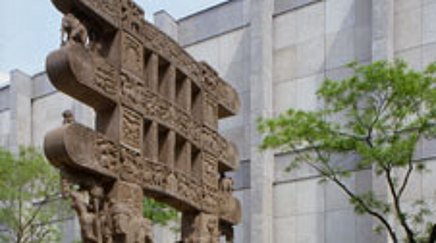

![[Translate to English:] [Translate to English:]](/fileadmin/_processed_/b/2/csm_Int_Koop_Scholz_Ausstellungsansicht1_dst_8c874a50f1.jpg)

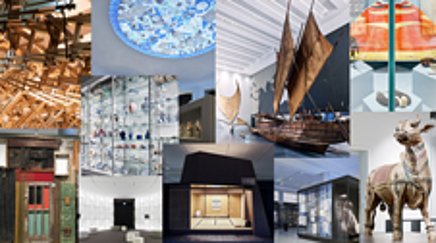
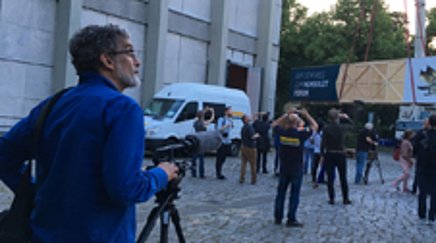
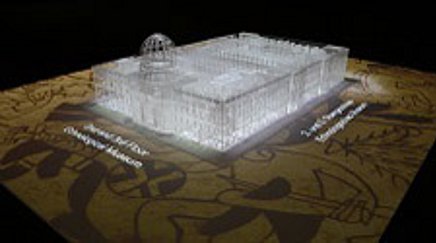
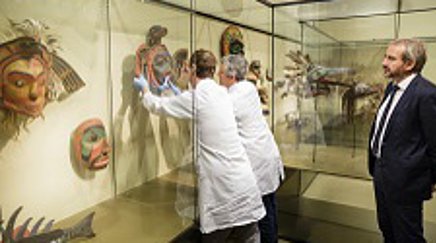
![[Translate to English:] Besucher bei der Ausstellung Living Inside the Story / Humboldt Lab Tanzania (Februar 2017). Besucher bei der Ausstellung Living Inside the Story / Humboldt Lab Tanzania (Februar 2017).](/fileadmin/_processed_/d/6/csm_Ausstellung-Lab-Tanzania-Dar-es-Salaam_ds1_25333185ee.jpg)
